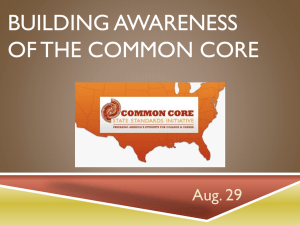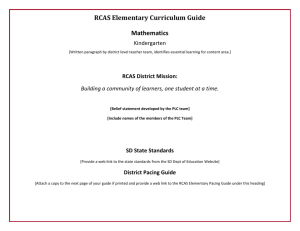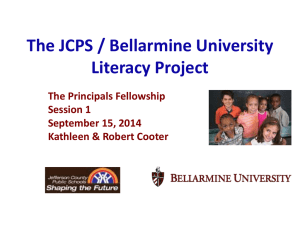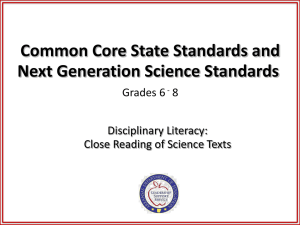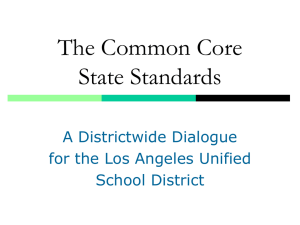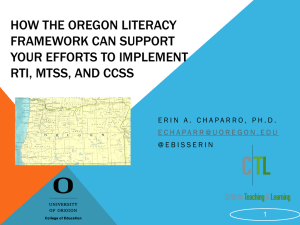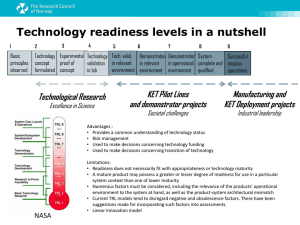CCSS Ready, Set, Launch BLT
advertisement
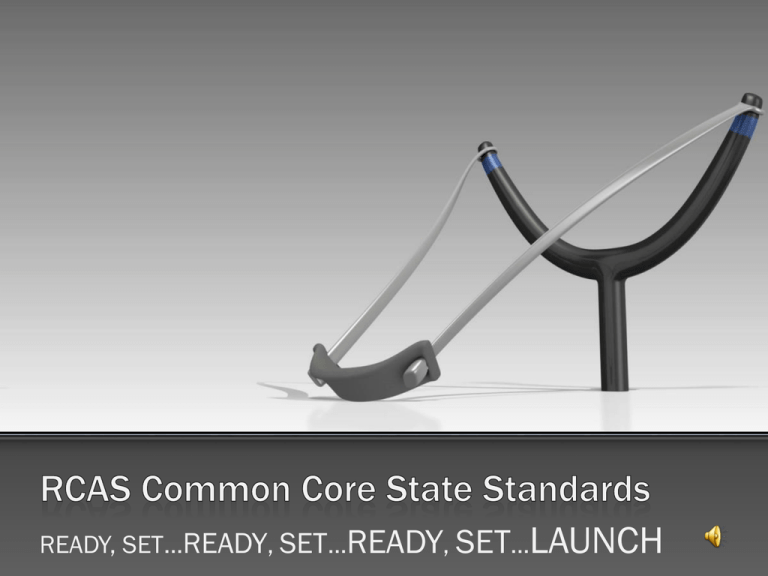
READY, SET…READY, SET…READY, SET…LAUNCH Mission Statement: The CCSS provide a consistent, clear understanding of what students are expected to learn, so teachers and parents know what they need to do to help them. The standards are designed to be robust and relevant to the real world, reflecting the knowledge and skills that our young people need for success in college and careers. (www.corestandards.org) L earn, laugh, lunch A ctive participation U se respectful interchanges N ew ideas to be explored C ell phones stowed away H alt sidebars and have a fun, productive day Today’s Learning Targets: · To develop common language and shared understanding of the Common Core State Standard (CCSS) documents. · To learn to navigate the CCSS template (disaggregating, or unpacking tool). Mission: Building a community of lifelong learners, one student at a time. Vision: Rapid City Area Schools Staff District Direction All Rapid City Area School students will achieve to their full potential. Guaranteed, Viable, Relevant Curriculum (Common Core State Standards) Comprehensive System of Assessment All Students Learning At High Levels Instructional Practices Balanced Literacy Inquiry Mathematics Technology Literacy Diverse Opportunities for Learning Success Four critical questions will drive our work in order to ensure that all students learn at high levels: 1. 2. 3. 4. What do we want students to learn? How will we know if our students are learning? How will we respond when students do not learn? How will we enrich and extend the learning for students who are proficient? RCAS Elementary Literacy Understand the framework and format. Develop common language. Develop an understanding of the actual standards. (Unpacking or Disaggregating) Connect the standards to teaching practices and student learning behaviors. (Teaching, Learning, Assessment) Develop a systematic plan for “chunking” the standards into manageable pieces. (Mapping, Pacing, Guaranteed Curriculum) Portrait of Students who meet the standards Pg. 7 Independent Comprehend and critique Strong content knowledge Value evidence Respond to varying demands Use technology and digital media Understand other perspectives and cultures Capabilities College and Career Readiness (CCR) Anchor Standards Pg. 10 4 Strands: Reading, Writing, Speaking and Listening, Language Reading Anchor Standards Pg. 10 Informational Text RI Literature RL Key Ideas and Details Craft and Structure Integration of Knowledge and Skills Range of Reading and Text Complexity Reading Standards for Literature and Informational Text Foundational Skills K- 1 Standards 1-4 1.Print Concepts K-1 2. Phonological Awareness K-1 Foundational Skills 2-5 Standards 3-4 3. Phonics and Word Recognition 4.Fluency 1. Understand the code: RL, RI, RF, W, SL, L R.CCR.2 (Reading. CCReadiness Anchor Standard 2) RL.3.2 (Reading Literature.3rd Grade.2nd Standard) 1. 2. 3. 4. Choose a standard. Write it in the template box. Write the anchor standard that grounds it. Write the correlating standard for the grade level below and above. 5. Discuss the relevance and application of this standard to real life. 6. Tables signal when finished. Prizes for efficiency. Highlight verbs and “big nouns” or concepts in the standard. KNOW and UNDERSTAND: Determine the amount of cognitive load placed on the learner. (You might craft some simple learning targets here.) Use resources to help…Webb leveling and Bloom’s Taxonomy. DO: How might a student demonstrate knowledge or understanding for this target? Write ideas or craft simple criteria for success statements. Identify any key vocabulary that supports this standard. Application and Synthesis How might I teach this standard? What instructional strategies would support student learning in this area? What resources do I have available to help me with lesson planning? When will I teach this standard? How will I calibrate my lessons and assessments to my teammates and district grade level? Building a Reading Life Sept. Following Characters Into Meaning Narrative Standards Oct. Nov. Dec. RCAS RCAS Reading Reading Workshop Workshop Units Units Navigating Nonfiction Informational Standards Jan. Feb. Mar Going Deeper with Complex Texts Apr. May Unit I Building a Reading Life Unit Focus Standards RL2 RI2 Power Standards RL10, RI10 TRL RF4 Fluency Unit Targets District Targets Stamina Routines & Habits Engagement Reading Volume Retell Summarize Main Idea Determining Importance Details Unit II Following Characters into Meaning Unit Focus Standards RL 1, 3, 5, 6, 7, 9 District Targets Personal Response Using Text Evidence Empathizing with Characters Making Connections Power Standards RL10, RI10 TRL RF4 Fluency Unit Targets Questioning Predicting Inferring Compare and Contrast Point of View Unit III Navigating Nonfiction Unit Focus Standards RI 1, 3, 4, 5, 6, 7, 8, 9 District Targets Inquiry Research Using Multiple Resources Critical Reading Power Standards RL10, RI10 TRL RF4 Fluency Unit Targets Summarizing Synthesis Determining Importance Text Features Text Structures Unit IV Going Deeper with Complex Texts Unit Focus Standards RL 4, 7, 9 RI 6, 7, 8, 9 District Targets Supporting your thinking with evidence Differing perspectives Power Standards RL10, RI10 TRL RF4 Fluency Unit Targets Synthesis Reasoning Cause /Effect Infer Meaning • “I can lead in my classroom by taking the standards from paper to practice.” • “I can lead in my grade level team by exploring, discussing, and creating in a collaborative way.” • “I can lead in my school by sharing ideas and supporting my principal’s efforts in moving our school forward toward full implementation of the CCSS.” • “I can lead in our school district by working with cross-district teams, communicating with my literacy leader, and sharing ideas. 1. A Greater Pool of Resources “When yesterday you might have shared your lesson across the hall, under the CCSS you’ll be able to share lessons with teachers across the country” (Kendall, 2011). 2. Increased Collegiality “A shared language is the essential first step for communication” (DuFour & Eaker, 1998; Kohm & Nance, 2009). The Common Core will provide great opportunity for an unprecedented level of discourse. 3. Increased Professionalism One hallmark of a profession is mastery of a body of knowledge. In education, the greater the challenge is for students, the more crucial it is that teachers have both a mastery of content and an understanding of teaching and learning. Understanding Common Core Standards by John Kendall RCAS Elementary Literacy
